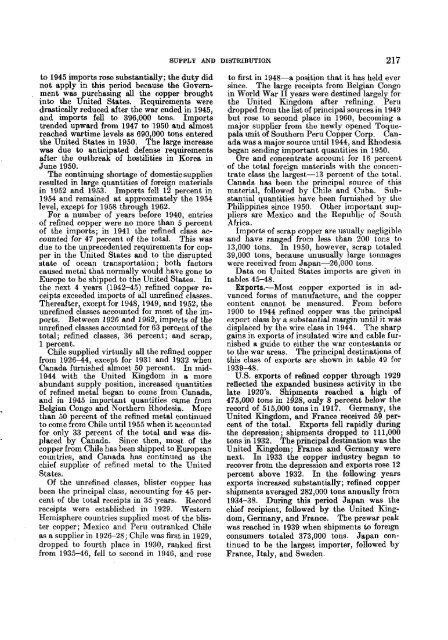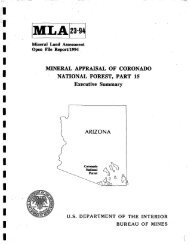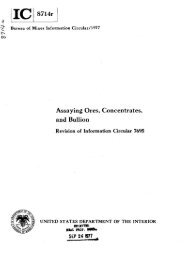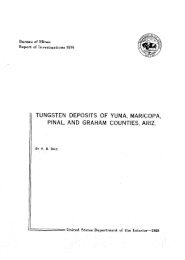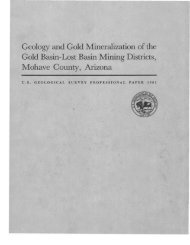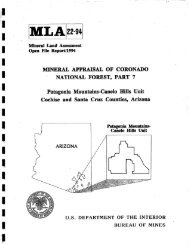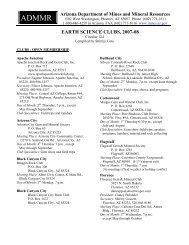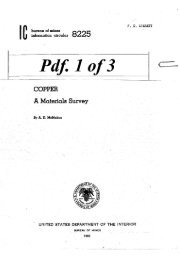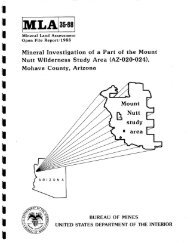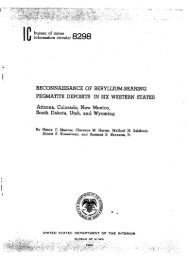IC 8225 - State of Arizona Department of Mines and Mineral ...
IC 8225 - State of Arizona Department of Mines and Mineral ...
IC 8225 - State of Arizona Department of Mines and Mineral ...
Create successful ePaper yourself
Turn your PDF publications into a flip-book with our unique Google optimized e-Paper software.
SUPPLY AND DISTRIBUTION 217to 1945 imports rose substantially; the duty didnot apply in this period because the Governmentwas purchasing all the wpper broughtinto the United <strong>State</strong>s. Requirements weredrastically reduced after the war ended in 1945,<strong>and</strong> imports fell to 396,000 tons. Im ortstrended upward from 1947 to 1950 <strong>and</strong> a ? mostreached wartime levels as 690,000 tons enteredthe United <strong>State</strong>s in 1950. The large increasewas due to anticipated defense requirementsafter the outbreak <strong>of</strong> hostilities in Korea inJune 1950.The continuing shortage <strong>of</strong> domesticsuppliesresulted in large quantities <strong>of</strong> foreign materialsin 1952 <strong>and</strong> 1953. Imports fell 12 percent in1954 <strong>and</strong> remained at approximately the 1954level, except for 1958 through 1962.For a number <strong>of</strong> years before 1940, entriea<strong>of</strong> refined copper were no more than 5 percent<strong>of</strong> the imports; in 1941 the refined class accountedfor 47 percent <strong>of</strong> the total. This wasdue to the unprecedented requirements for copperin the United <strong>State</strong>s <strong>and</strong> to the disruptedstate <strong>of</strong> ocean transportation; both factorscaused metal that normally would have gone toEurope to be shipped to t'he United <strong>State</strong>s. Inthe next 4 years (194245) refined copper receiptsexceeded imports <strong>of</strong> all unrefined classes.Thereafter, except for 1948,1949, <strong>and</strong> 1952, theunrefined classes accounted for most <strong>of</strong> the imports.Between 1926 <strong>and</strong> 1962, imports <strong>of</strong> theunrefined classes accounted for 63 percent <strong>of</strong> thetotal; refined classes, 36 percent; <strong>and</strong> scrap,1 percent.Chile supplied virtually all the refined copperfrom 192644, exce t for 1931 <strong>and</strong> 1932 whenCanada furnished a P most 50 percent. In mid-1944 with the United Kingdom in a moreabundant suppl position, increased quantities<strong>of</strong> refined meta 9 began to come from Canada,<strong>and</strong> in 1945 important quantities came fromBelgian Congo <strong>and</strong> Northern Rhodesia. Morethan 50 percent <strong>of</strong> the refined metal continuedto come from Chile until 1955 when it accountedfor only 33 percent <strong>of</strong> the total <strong>and</strong> was displacedby Canada. Since then, most <strong>of</strong> thecopper from Chile has been shipped to Europeancountries, <strong>and</strong> Oanada has continued as thechief supplier <strong>of</strong> refined metal to the United<strong>State</strong>s.Of the unrefined classes, blister copper hasbeen the principal class, accounting for 45 percent<strong>of</strong> the total receipts in 35 years. Recordreceipts were established in 1929. WesternHemisphere countries supplied most <strong>of</strong> the blistercopper; Mexico <strong>and</strong> Peru outranked Chileas a supplier in 1926-28; Chile was first in 1929,dropped to fourth place in 1930, ranked firstfrom 193546, fell to second in 1946, <strong>and</strong> roseto iirst in 1948-a position that it has held eversince. The large receipts from Be1 'an Congoin World War I1 years were destine&argely forthe United Kingdom after refining. Perudropped from the list <strong>of</strong> principal sources in 1949but rose to second place in 1960, becoming amajor supplier from the newly opened Toquepalallnit <strong>of</strong> Southern Peru Copper Corp. Canadawas a major source until 1944, <strong>and</strong> Rhodesiabegan sending important quantit'ies in 1950.Ore <strong>and</strong> concentrate account for 16 percent<strong>of</strong> the total foreign materials with the concentrateclass the largest-13 percent <strong>of</strong> the total.Canada has been the principal source <strong>of</strong> thismaterial, followed by Chile <strong>and</strong> Cuba. Substantialquantities have been furnished by thePhilippines since 1950. Other important suppliersare Mexico <strong>and</strong> the Republic <strong>of</strong> SouthAfrica.Imports <strong>of</strong> scrap copper are usually negligible<strong>and</strong> have ranged from less than 200 tons to13,000 tons. In 1950, however, scrap totaled39,000 tons, because unusually largo tonnageswere received from Japan-26,000 tons.Data on United <strong>State</strong>s imports are given intables 4548.Exports.-Most copper exported is in advancedforms <strong>of</strong> manufacture, <strong>and</strong> the coppercontent cannot be measured. From before1900 to 1944 refined copper was the principalexport class by a substantial margin until it wasdisplaced by the wire class in 1944. The sharpgains in exports <strong>of</strong> insulated wire <strong>and</strong> cable furnisheda guide to either the war contestants orto the war areas. The principal destinations <strong>of</strong>this class <strong>of</strong> exports are shown in table 49 for193948.US. exports <strong>of</strong> refined copper through 1929reflected the exp<strong>and</strong>ed business activit in tbelate 1920's. Shipments reached a zigh <strong>of</strong>475,000 tons in 1928, only 8 percent below therecord <strong>of</strong> 515,000 tons in 1917. Germany, theUnited Kingdom, <strong>and</strong> France received 59 percent<strong>of</strong> the total. Exports fell ra idly duringthe depression; shipments droppe cf' to 111,000tons in 1932. The principal destmation was theUnited Kingdom; France <strong>and</strong> Germany werenext. In 1933 the copper industv began torecover from the depression <strong>and</strong> exports rose 12percent above 1932. In the following yearsexports increased substantially; refined coppershipments averaged 282,000 tons annually from1934-38. During this period Japan was thechief recipient, followed by the United Kingdom,Germany, <strong>and</strong> France. The prewar peakwas reached in 1939 when shipments to foreignconsumen totaled 373,000 tons. Japan continuedto be the largest importer, followed byFrance, Italy, <strong>and</strong> Sweden.


